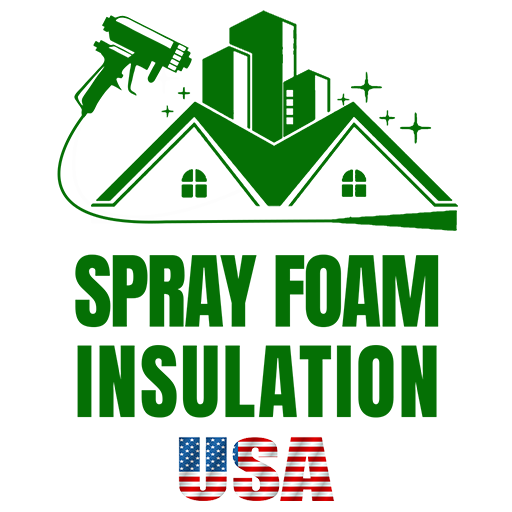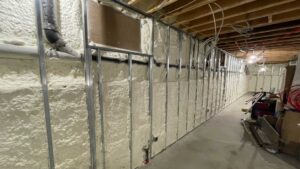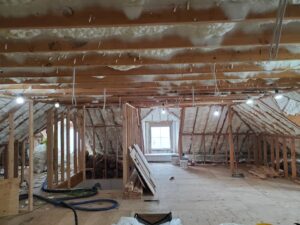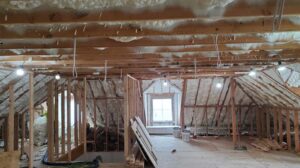Introduction
When it comes to asbestos attic insulation, you want to know quickly how to detect it and ensure your safety. Asbestos was a popular insulating material in homes built before the 1980s because of its excellent heat resistance and insulation properties. Unfortunately, it poses significant health risks, which were not widely recognized until the late 20th century. This intro provides a snapshot of asbestos history and the evolution of insulation practices to better understand why and how asbestos was used in attics.
Asbestos has been used historically for its durable and fire-resistant properties, dating back thousands of years, but it was the industrial era that saw its peak in building materials. In homes, particularly those built in the mid-20th century, asbestos was commonly used in attic insulation because of its effectiveness in minimizing heat transfer and conserving energy. However, once disturbed, these insulation fibers can become airborne and pose serious health hazards, including lung cancer and mesothelioma.

Understanding these aspects can prepare you to deal with the risks associated with asbestos in your home safely and knowledgeably.
Understanding Asbestos Insulation
Asbestos is a naturally occurring mineral known for its durability and resistance to heat and corrosion. This made it an ideal material for insulation in homes and buildings for many years. However, its fibers are highly toxic when inhaled, leading to severe health issues including lung cancer and mesothelioma.
Asbestos Properties
Asbestos fibers are tiny and can easily become airborne. Once airborne, they can be inhaled and become lodged in the lungs, leading to inflammation and serious diseases. The properties that once made asbestos popular in construction—such as its resistance to heat—are the same properties that make it hazardous.
The Vermiculite Connection
Vermiculite, a mineral used in various construction applications, including insulation, often contains asbestos fibers. It expands when heated and is lightweight, making it suitable for attic insulation. Unfortunately, much of the vermiculite mined in Libby, Montana, was found to be contaminated with asbestos, leading to widespread health hazards.
Zonolite Brand
One of the most well-known brands of vermiculite insulation is Zonolite, which was heavily mined and distributed by W.R. Grace. The mine in Libby was responsible for supplying the majority of the world’s vermiculite. Zonolite insulation has been used in millions of homes and poses a significant health risk due to its asbestos content.
If your home has attic insulation that you suspect may contain vermiculite, it’s crucial to not disturb it. Disturbing vermiculite insulation can release asbestos fibers into the air, which can be harmful when inhaled.
Understanding these aspects of asbestos attic insulation is crucial for managing and mitigating the risks associated with this material. If you suspect the presence of asbestos in your home, contact professionals who can safely assess and handle the material.
Identifying Asbestos in Your Attic
Identifying asbestos attic insulation involves understanding visual cues, recognizing vermiculite characteristics, and noting specific colors and textures. Here’s how you can identify potential asbestos-containing materials in your attic without disturbing them.
Visual Cues
When looking at your attic insulation, observe the material’s appearance closely:
- Fluffy and Loose: Asbestos insulation often appears fluffy and loose, similar to cotton candy but in a grayish or silvery tone.
- Pebble-like Appearance: Vermiculite insulation, which may contain asbestos, typically looks like small, shiny pebbles or gravel. It’s usually gray, brown, or silver-gold in color.
Vermiculite Characteristics
Vermiculite itself is a mineral with a layered structure that expands when heated. In insulation, it’s used in a loose-fill form, which means it’s poured into spaces rather than applied as sheets or rolls. Key characteristics include:
- Lightweight and Fire-resistant: Vermiculite is lightweight, making it easy to pour, and it has natural fire-resistant properties.
- Granular Texture: The granules are typically small and may glisten slightly due to their mineral composition.
Color and Texture
The color and texture of your attic insulation can provide significant clues:
- Color Variations: Look for insulation that is grayish, brown, or silvery-gold. These colors are typical of vermiculite that may contain asbestos.
- Texture: Asbestos-containing vermiculite has a unique texture that resembles small, rocky granules.

Safety Note: If you identify insulation in your attic that matches these descriptions, do not touch or disturb it. Disturbing asbestos-containing materials can release harmful fibers into the air.
Understanding these visual and textural cues is essential for safely managing asbestos attic insulation. If you suspect your insulation contains asbestos, it’s crucial to leave it undisturbed and consult with professionals who specialize in asbestos testing and removal. Safety first—never attempt to handle or remove suspected asbestos materials on your own.
Health Risks and Safety Measures
When dealing with asbestos attic insulation, understanding the health risks and implementing safety measures are crucial. Asbestos exposure, even in small amounts, can have serious long-term health consequences.
Asbestos Exposure
Asbestos fibers are tiny and when disturbed, they can easily become airborne. Once inhaled, these fibers can settle in the lungs or stomach, which can lead to serious health issues over time. It’s important to know that these fibers are invisible to the eye and can linger in the air for hours, making them particularly dangerous.
Diseases Linked to Asbestos
Exposure to asbestos can lead to several severe diseases, which often appear decades after exposure:
- Asbestosis: This is a chronic lung disease that results in respiratory issues and can lead to lung cancer.
- Mesothelioma: A rare and aggressive cancer that affects the lining of the lungs, chest, abdomen, and other organs. This is almost exclusively linked to asbestos exposure.
- Lung Cancer: Asbestos increases the risk of lung cancer, especially in smokers.
The latency period for these diseases can be up to 30-40 years, meaning symptoms might not become apparent until long after exposure.
Safety Protocols
To minimize risks, strict safety protocols must be followed:
- Do Not Disturb: If you suspect your attic contains asbestos, do not touch or disturb the insulation. Movement can release fibers into the air.
- Professional Testing and Removal: Always hire a professional with expertise in asbestos for testing and removal. They have the necessary tools and knowledge to handle the material safely.
- Proper Protective Gear: Professionals use specific protective gear, including respirators that can filter out asbestos fibers, full-body suits, and gloves.
- Legal Compliance: Asbestos removal must comply with local and federal regulations to ensure safe disposal and prevent contamination.
Remember: Never attempt to remove asbestos on your own. The health risks associated with improper handling are significant, not only to you but also to others living in your home.
In conclusion, dealing with asbestos attic insulation requires a careful approach to ensure safety and compliance with health standards. If you suspect the presence of asbestos, the best course of action is to contact professionals who can safely test and, if necessary, remove the material. This is not only a matter of legal compliance but also of ensuring the long-term health and safety of everyone in your home. As we move into the next section, we’ll discuss how professionals assess and handle asbestos materials and why it’s crucial to choose seasoned experts like those at Spray Foam Insulation USA for such tasks.
Professional Assessment and Removal
When dealing with asbestos attic insulation, the importance of professional involvement cannot be overstated. Here’s how to approach the assessment and removal process:
Hiring Experts
It’s crucial to hire certified professionals when you suspect the presence of asbestos in your home. These experts have the training and tools required to handle hazardous materials safely. Look for professionals with:
- Certifications: Ensure they are certified in asbestos assessment and removal.
- Experience: Choose professionals with a solid track record in handling asbestos.
- Proper Equipment: Professionals should use advanced equipment for testing and removal.
Choosing a reputable company like Spray Foam Insulation USA guarantees that these criteria are met, ensuring safe and effective handling of asbestos materials.
Testing for Asbestos
Before any removal or encapsulation, confirm the presence of asbestos through professional testing. This process typically involves:
- Sample Collection: Experts collect samples of the suspected materials while adhering to safety protocols.
- Laboratory Analysis: Samples are analyzed in a lab to confirm the presence and type of asbestos.
This step is vital as it determines the appropriate action—whether removal or encapsulation—and ensures that all actions taken are necessary and based on accurate information.
Removal vs. Encapsulation
Once asbestos is confirmed, the next step is deciding between removal or encapsulation:
- Removal: This process involves completely eliminating asbestos materials from your property. It’s often recommended if the asbestos is in poor condition or if major renovations are planned.
- Encapsulation: This method involves covering the asbestos material with a protective barrier to prevent fibers from becoming airborne. It’s a viable option when asbestos is in good condition and not likely to be disturbed.
Professionals like those at Spray Foam Insulation USA can advise on the best course of action, considering factors like the condition of the asbestos, future home improvement plans, and overall safety.
Spray Foam Insulation USA
Choosing Spray Foam Insulation USA ensures that you’re working with a team that not only understands the intricacies of asbestos removal and encapsulation but also prioritizes your safety and compliance with all regulatory standards. Their expertise in the field ensures that they handle every aspect of the process, from initial testing to final disposal, with the utmost professionalism and adherence to safety standards.
By entrusting this task to Spray Foam Insulation USA, you ensure that your home becomes a safer environment, free from the risks associated with asbestos exposure. Their approach not only addresses immediate concerns but also contributes to the long-term health and safety of your household.
In conclusion, dealing with asbestos attic insulation requires a careful, professional approach to ensure safety and compliance. Hiring experts, conducting thorough testing, and choosing between removal or encapsulation are steps that must be handled with precision. With the right professionals on your side, you can achieve a safe and asbestos-free home.
Preventive Measures and Alternatives
When dealing with asbestos attic insulation, prevention and choosing the right alternatives are key to ensuring your home is safe and energy-efficient.
Prevention Tips
- Regular Inspections: Schedule annual inspections of your attic to check for any signs of aging insulation that might contain asbestos.
- Immediate Action: If you suspect asbestos, do not disturb the area. Asbestos fibers can become airborne and pose health risks.
- Educate Yourself: Understand the appearance and risks of asbestos-containing materials. Knowledge is your first line of defense.
Eco-friendly Alternatives
Switching to eco-friendly insulation alternatives not only reduces health risks but also benefits the environment:
- Cotton Denim: Made from recycled denim fabric, this insulation is non-itchy and contains no irritating chemicals.
- Cellulose: Comprising mainly recycled newspaper, treated for fire resistance, it’s effective at blocking air leaks.
- HempWool®: A sustainable choice made from hemp, it offers good insulation performance and is non-toxic.
These alternatives are not just safer; they also provide excellent insulation, helping to keep your home comfortable year-round.
Spray Foam Benefits
Spray Foam Insulation USA offers a modern solution that stands out for several reasons:
- Energy Efficiency: Spray foam seals cracks and gaps, reducing air leaks and lowering energy costs.
- Durability: Unlike traditional insulation materials, spray foam does not settle or degrade over time, maintaining its effectiveness.
- Moisture Barrier: It helps prevent moisture build-up, reducing the risk of mold and mildew in your attic.
Choosing the right insulation, like spray foam, can lead to significant energy savings and enhance the comfort of your home. Always consult with professionals to ensure you’re making the best choices for your insulation needs.
By adopting these preventive measures and considering eco-friendly alternatives like spray foam, homeowners can create a safer, more energy-efficient living environment. This proactive approach not only addresses the immediate concerns associated with asbestos attic insulation but also contributes to the long-term health and safety of residents.
Frequently Asked Questions about Asbestos Attic Insulation
What does asbestos insulation look like?
Identifying asbestos attic insulation by sight alone can be tricky, as it often resembles other insulation types. However, some clues can help:
- Vermiculite insulation often looks like small, shiny pebbles or particles that are gray-brown or silver-gold in color. This type of insulation is highly likely to contain asbestos if installed before 1990.
- Loose-fill asbestos appears fluffy and can be a variety of colors, including gray, white, or even blue.
Visual identification isn’t foolproof. If you suspect your insulation contains asbestos, it’s best to avoid disturbing it and consult a professional.
How dangerous is asbestos in the attic?
Asbestos poses serious health risks when its fibers become airborne and are inhaled. In the attic, these risks are elevated if the insulation is disturbed during renovations, repairs, or even routine maintenance. Health complications from asbestos exposure can include:
- Lung cancer
- Mesothelioma, a rare form of cancer almost exclusively caused by asbestos exposure
- Asbestosis, a serious fibrotic lung disease
The danger is not immediate, but long-term exposure can lead to these severe conditions, often manifesting decades after the initial exposure.
Can I remove asbestos insulation myself?
No, removing asbestos insulation yourself is highly discouraged. Asbestos removal requires specialized knowledge, tools, and safety measures to prevent contamination and exposure. Here’s why professional removal is crucial:
- Safety equipment: Professionals use high-grade respirators and protective suits designed to protect against asbestos fibers.
- Legal regulations: There are specific legal requirements for asbestos handling and disposal that professionals are trained to comply with.
- Containment and filtration: Experts use containment strategies and air filtration devices to prevent the spread of asbestos fibers during removal.
Attempting to remove asbestos without the proper equipment and experience can increase the risk to your health and spread contamination throughout your home.
For any concerns about asbestos attic insulation, it’s best to contact a qualified professional who can assess the situation and safely handle the removal if necessary. This approach ensures the safety of your household and compliance with all health regulations.
Conclusion
Awareness is Key
Understanding the risks associated with asbestos attic insulation is crucial for homeowners. Asbestos, once a popular insulation material, can pose serious health risks if disturbed. The tiny fibers can become airborne and, when inhaled, lead to severe respiratory issues, including asbestosis and mesothelioma. It’s vital to recognize the potential presence of asbestos in older homes, particularly those built before the 1990s.
Seeking Professional Help
If you suspect that your attic might contain asbestos insulation, it is imperative to seek professional help. Do not attempt to handle or disturb the insulation yourself. Professionals equipped with the right tools and knowledge can safely assess and manage the removal of asbestos materials. They ensure that the process is conducted under controlled conditions to prevent any exposure.
At Spray Foam Insulation USA, we understand the importance of safe insulation solutions. While we do not handle asbestos removal directly, we can guide you in finding certified experts for asbestos testing and removal. Once the asbestos is safely removed, we can provide high-quality, safe, and efficient insulation alternatives like spray foam to enhance your home’s energy efficiency and comfort.
Why Choose Spray Foam Insulation USA?
Choosing to work with Spray Foam Insulation USA means opting for a partner who values your safety, comfort, and energy efficiency. After the safe removal of any hazardous materials, our team of experts can transform your attic with top-tier spray foam insulation. This upgrade not only secures your home from energy loss but also improves indoor air quality and overall comfort.
Dealing with asbestos attic insulation is not just about improving energy efficiency—it’s about ensuring the health and safety of your family. Let us help you make your home safe and comfortable. If you have any concerns regarding asbestos or wish to upgrade your insulation, do not hesitate to contact us for a consultation and expert advice. Together, we can achieve a safer, more energy-efficient home.





